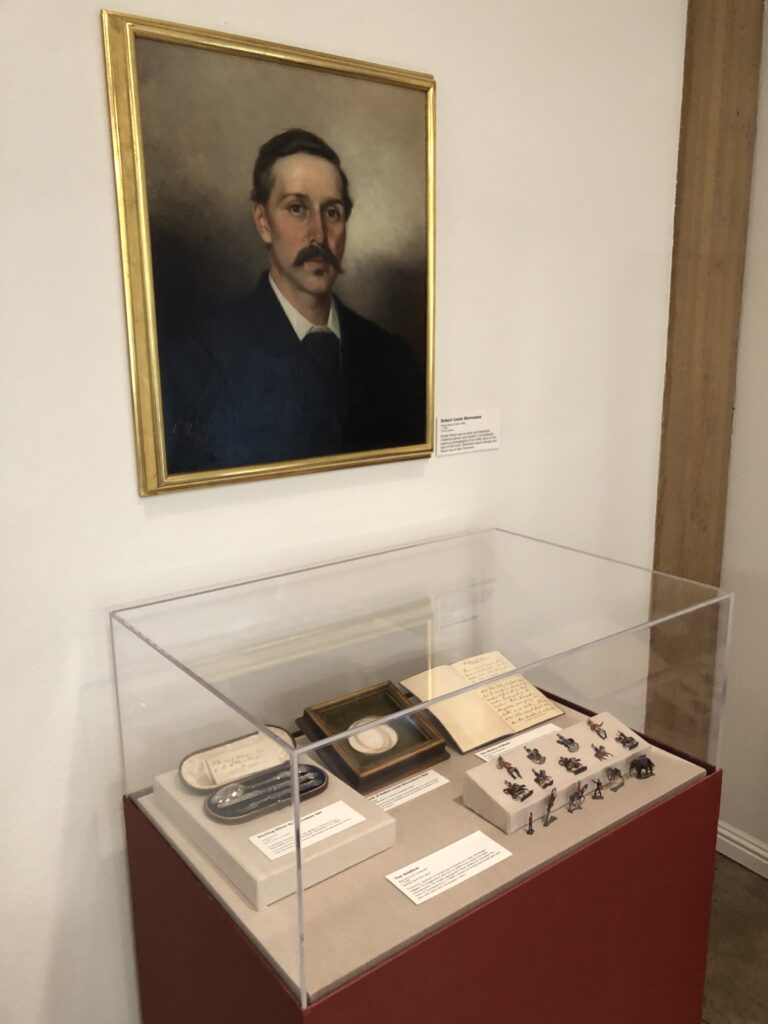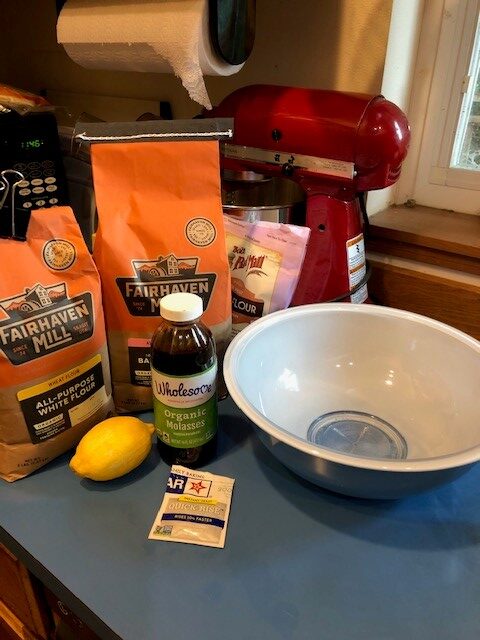Pirates, Robert Louis Stevenson, and Ben Gunn’s Favorite Recipe

The Tale Behind the Tale of Winking Kat’s musical adaptation of “Treasure Island”
Several years ago, I had the pleasure of being commissioned to write a musical version of Robert Louis Stevenson’s classic adventure tale, “Treasure Island”. Along with composer, Terence Levitt, we first created a musical for a touring company of five actors, four of whom played many different roles in the story. It was great fun. A couple years later, we went back and expanded the musical to accommodate a large cast of elementary school students. We added skeletons, parrots, and (of course) more pirates. Our podcast version of the musical is a hybrid of both adaptations.
Robert Louis Stevenson, author and adventurer

Brief Biography
Like the beginning of “Treasure Island”, Stevenson’s life began far from the Caribbean Sea. He was born in November of 1850 in Edinburgh, Scotland. His father wanted him to grow up, follow in his footsteps, and become a lighthouse engineer. Robert did go to Edinburgh University to study engineering, but his poor health. At the time they described it as ‘weak lungs’ from a premature birth. The condition made it difficult for him to hold a steady engineering job. It also meant that he often needed to retreat from the damp, cold, Scottish climate, so he spent many years in Southern France.
When he was a boy, his aunt and uncle gave Robert a toy theater. That toy sparked his interest in telling stories. As he grew older, his love of telling stories and writing led to the creation of many essays and short stories. After he passed the bar exam in 1875, Stevenson decided to go back to France to vacation. In 1876, in France, he met a married American woman, Fanny Osborne who was in France with her son. They became very close friends.
After the success of his short story, “Lodging for the Night”, Stevenson made the huge decision to travel to the Monterey, California to see Fanny again. There in 1880, he suffered a hemorrhage, A recently divorced Fanny invited Robert to move in with her so she could help take care of him. Stevenson marries Fanny in May of that year.
The couple returned to Europe and stayed in Switzerland until the end of 1880. In 1881, Robert returned to Scotland after mending a rift with his father. It was in 1881 in Edinburgh where he began writing “The Sea Cook”, a story with was re-titled and became “Treasure Island”.
Still in poor health, Steven couldn’t travel for over two years. During that time he wrote “A Child’s Book of Verses”, “Dr. Jekyll and Mr. Hyde”, and “Kidnapped”. Then in 1887, after his father’s death, Robert, Fanny, her children, and Robert’s mother go back to America and spend some time living in a cabin in the Adirondacks of New York.
They spent almost a year there and with friends in New Jersey before Fanny and Robert went west and returned to San Francisco. In the years before his death, Stevenson sailed on many adventures in the South Pacific – visiting Hawaii, the Cook Islands. Australia, and Tahiti. He and Fanny eventually bought an estate in Samoa. There his health continued to decline. Stevenson died of a cerebral hemorrhage in 1894. The Samoan people buried him with honors on Samoa.
Like his novel, “Treasure Island”, Stevenson’s life began far from tropical waters where he eventually came to rest.
ANONYMOUS
First Edition copies of his books as well as artifacts, letters, and other items used by Fanny and Robert Louis Stevenson can be found at the Stevenson museum in St. Helena, California north of San Francisco.


Pirates or Privateers? -What was the difference?
European explorers first came to North and South America looking for a faster way to sail to India, China, and the rich countries of Asia. What they found in the Americas – particularly Central and South America- were native civilizations that had accumulated vast amounts of gold, silver, and precious gems. The Europeans, with their advantage of horses and gunpowder, overwhelmed the indigenous populations and began shipping their treasures back to Europe.
Knowing treasure was often on the merchant ships sailing back to France, Portugal, Holland, Spain, and England thieves of the sea or pirates began attacking the merchant ships to steal their precious cargo. Pirates had no rules and would attack any ship they thought had something valuable. One famous pirate was Blackbeard, whose real name was Edward Teach.

Like many pirates, Teach began his pirating career as a Privateer.
A Privateer is someone who has a special letter called a “Letter of Marque” from the government of a country. The letter states that the privateer is acting on behalf of a government and robbing ships belonging to a different government who is at war with the first country.
Confusing? Yes. Let’s take the example the privateer Sir Francis Drake.

England and Spain were at war in the late 1500’s. Drake obtained orders from the British government to seize as many Spanish merchant ships and ports as possible. As a privateer with a Letter of Marque, if he were captured, Drake was supposed to be treated like a prisoner of war. The Letter of Marque was rarely respected and many privateers were arrested and executed as pirates if they were captured.

Women Were Pirates, Too
One pirate who was never executed was Anne Bonney, one of the few woman who commanded a pirate ship. She was born in Ireland in the early 1700’s and moved with her family to South Carolina. The story goes that she refused to marry the man her father wanted her to and eloped with a sailor named James Bonney when she was 16. She sailed with him as he took up piracy near the Bahamas. Records indicate that she was captured but wasn’t executed because she ‘pleaded her belly’ meaning because she was pregnant at the time. After Anne was released, she again took up piracy for a year then disappeared. No one really knows when or where she died.
Ben Gunn’s Favorite Recipe- Warm Cheese on Toast
In our adaptation of “Treasure Island” and Stevenson’s book, the poor, marooned character, Ben Gunn, has one wish – to go back to England and have warm cheese melted on toast. We took that to mean a favorite British dish, Welsh Rarebit. We took it a step further and decided to make a special bread to go with it.

Making the Barley Bread
The tough part of making this recipe was finding barley flour. It turns out a mill only an hour away, Fairhaven Mill in Burlington, Washington, produces all kinds of traditional flours including barley, I drove there and bought some freshly milled barley flour.

I found a great recipe online (I must credit this to Linda Whitworth in Alberta) then tweaked it a little for some fun.
Ingredients
For the Barley Bread (2 med loaves)
- 2 cups water-heated to @108 degrees F
- (about 450 ml)
- 1 1/2 Tbsp. (22 ml) Honey or
- 1 1/2 Tbsp sugar (@ 24 grams)
- 1 Tbsp (7- 8 grams) yeast
- 1 1/4 cups (150 grams) barley flour
- 3 cups (360 grams) all purpose flour
- 1 Tbsp (8 grams) Bob’s Red Mill Gluten Flour
- 1 Tbsp + 2 1/2 tsp (22 ml) vegetable oil
- 1 Tbsp + 2 tsp (20 ml) lemon juice
- 1 1/2 tsp salt

Pour heated water into a medium to large bowl. Dissolve honey or sugar into the water. Sprinkle the yeast over the top (stir lightly).
Let the yeast sit for about 10 minutes until frothy.
Then add the barley and all purpose flours, gluten flour, oil, lemon juice, and salt. Mix with a bread hook attachment on you mixer or mix by hand. Kneading by hand is often best to make sure you don’t over work the dough. Lightly flour a flat surface. Turn out the dough on the surface and begin kneading – adding flour if necessary to get a good texture. Look for strands of gluten in your dough. When you see good gluten strands, oil a clean bowl and set the dough in the bowl for the first rise. Cover the bowl with a damp tea towel and let sit in a warm, still place for about 30 minutes.
Dough should be about double in size. Prepare your bread pans by spraying VERY lightly with vegetable oil spray. Turn the dough back onto the flat surface and knead again for a few turns. Divide the dough if necessary to roll and fit into loaf pan(s). The roll should be the length of the pan and about half the height. Cover again and let sit for a second rise of about 45 – 60 minutes or until doubled in size.

Heat oven to 375 degrees F (190 C). When dough & oven are ready, place the bread pans in the center of the oven & bake for about 25 minutes or until light golden brown on top. Bread should sound hollow when tapped. Let cool.
“In three long years what I missed the most…
missed the most,
is golden cheese, melted on toast.
Ben Gunn, from the song “Marooned” in Treasure Island
Cheese Sauce

- 2 Tbsp butter
- 2 Tbsp flour
- 1/4 tsp salt
- a pinch of pepper
- 1/4 tsp dry mustard
- 1/4 tsp smoked Paprika
- 1/2 tsp Worchestershire sauce
- 1/2 cup whole milk
- 1/4 cup beer
- 3/4 cup shredded Cheddar cheese
- 1 drop Tabasco sauce (if desired)
In a small saucepan, melt the butter over medium-low heat. Be careful not to burn. Whisk in the flour, salt, pepper, mustard, paprika, and Worchestershire sauce. Keep whisking until the mixture is smooth with no lumps.
Take the pan off the heat and whisk in the milk slowly. When the milk is incorporated into the butter/flour mixture, return the pan to the heat and bring the milk to a boil while continually stirring. Keep stirring and add the beer. NOTE: The alcohol will evaporate but you can use non-alcoholic beer if you have any concerns. Cook about one more minute than add the shredded cheese a little at a time while continuing to stir. When all the cheese is melted into the mixture, remove it from the heat.

Lightly toast slices of the barley bread and set on your plates. Pour the warm cheese sauce generously over the toasted bread and serve.
YUM. Ben Gunn would be soooo happy.

